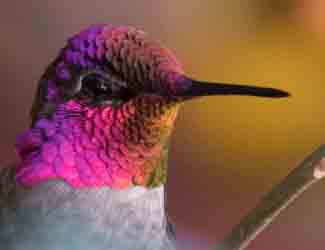Which Bird Can Fly Backwards
and Why?
Although birds are known for their ability to accelerate and turn while cruising through the air, their flying ability comes with some limitations. However, this is not the case, as some birds can fly backwards and even upside down, albeit for short periods. So which bird can fly backwards and why?
The hummingbird is the only bird that can truly fly backward. It does this to help with hovering while drawing nectar from plants. Additionally, it assists for safety reasons to get a better vantage point over predators and make quick stops to prevent collisions or to change directions.
This article will explain in detail how and why the hummingbird flies backward. It will also present several of the hummingbird’s unique features and how to attract these tiny birds to your yard. Read on for everything you ever wanted to know about hummingbirds.

Which Bird Can Fly Backwards?
While some birds, such as herons and egrets, may give the impression of fluttering backward, only one bird truly flies in this direction – the hummingbird. This tiny bird can fly in all directions, including forward, backward, sideways, and even upside down.
Unlike other bird species, hummingbirds have unique features that allow them to perfect these flying abilities. These features include their special wings and their tiny size. Hummingbirds rank as some of the tiniest birds in the world.
Let’s look at why the hummingbird would fly backward in the first place and how it accomplishes this feat.
Why It Flies Backwards
It’s totally understandable to wonder which bird can fly backwards and why, as birds come in different sizes and with different abilities. However, for a bird with the lifestyle of the hummingbird, flying backwards comes with numerous benefits.
First, the hummingbird feeds while hovering. This task would be impossible if the bird could not fly in reverse. Having bidirectional flying skills allows it to maintain its position while drawing nectar from a flower.
Second, if the bird’s vantage point while looking for predators is not broad enough, it can easily back up mid-flight to get a better view. Having this ability often means the bird gets the chance to escape.
Finally, we have all seen how quickly hummingbirds fly. It can almost be compared to speed racing a car. What does a car have that birds do not? It has brakes. As we have already established, the hummingbird differs from the average bird, and its ability to fly backward acts like a braking system. This allows the bird to avoid collisions or quickly change directions.
Interestingly, the hummingbird does not expend more energy to fly backward than it does to fly forward. While its speed is not as great traveling in reverse as it is moving forward, it is still highly efficient moving in either direction.
How It Flies Backwards
While the hummingbird is one of the tiniest birds, it has a very intricate skeleton that includes a rotator cuff. Much like humans, this rotator cuff allows for a full range of movement of the bird’s shoulder. Because the bird can complete an entire figure eight with its wing, it can push air in different directions, resulting in the ability to move multi-directionally.
Additionally, their muscles are strong enough to pull their wings in all directions. Other birds have strong muscles to force the wind in a direction to propel them forward but cannot move the wind to create reverse movement.
Hummingbird Traits...What Makes Them So Special?
Flying in all directions is not the only unique trait of hummingbirds. These little creatures have many special features that make them something to behold.
From wing speeds to an exceedingly fast heart rate, let’s look at the characteristics that make this bird so interesting.
Hummingbird Wing Speed
You may have noticed that as a hummingbird flies, its wings are a blur. While most birds in flight give a general impression of their wings, at the very least, you will never get this from a hummingbird in the air.
Their wings move at an incredible rate of speed. They can flap them 60 to 80 times per second. Because of this, they can reach speeds of up to 75 mph (120.70 km/h). Interestingly, because of their ability to fly backward, they can go from 25 mph (40.23 km/h) to a complete stop in only a couple of inches.
Hummingbirds Have Iridescent Feathers

Hummingbirds feature wings with colors that change in the light. As with many other birds and species of animals, the males are brighter than the females, making them showier. You will only truly see this characteristic when a hummingbird stops to take a break on a branch.
Hummingbirds Lap Their Food
While they stick their long beaks far into a plant to collect nectar, hummingbirds are not using them to pull the nectar from the plant. Instead, they use their tongues to lap the nectar inside the plant.
This is a speedy process, with their tongues moving at a rate of 15 laps per second. Additionally, their meals only last for a minute, but they will eat multiple times daily. Despite being so small, they have been known to consume up to eight times their own weight.
Hummingbirds Cannot Walk
Part of the reason hummingbirds use flying in reverse to help them hover in place is that they cannot walk. Their feet are extremely weak because of their minuscule size.
While the extra light feet help make them more efficient for flying, it makes the bird incapable of hopping or walking. It is limited to standing on a branch. Instead, you are more likely to see a hummingbird hover.
Hummingbirds Have Enormous Hearts
A completely relative fact, hummingbirds’ hearts are enormous. They comprise 2.5% of the birds’ body weights, making them bigger than most mammals. This makes a lot of sense when you consider how many times they beat, which can be up to 1,260 beats per minute.
Hummingbirds Come in a Wide Variety of Species
In total, 330 known species of this bird are native only to the Americas. These birds do not do well in captivity, so you will not generally find them as housepets. You can also find some hummingbirds in European zoos.
Hummingbirds Get Their Names From the Sound of Their Wings
Depending on the species, a hummingbird’s wings can beat anywhere from 720 to 5,400 times per minute while hovering. The energy burned by the motion of their wings is so excessive that they spend a significant amount of time perching to recover it.
If you have ever gotten close enough to a hummingbird in flight, you may have noticed it makes a humming noise. The humming sound made by these birds when in flight is the origin of the name ‘hummingbird.’
Hummingbirds Are Not the Only Bird That Can Fly Upside Down
While I mentioned that hummingbirds can also fly upside down, you may be surprised to learn that this trait is not unique to this species. Peregrine falcons can also fly upside down if they choose to. It is uncommon behavior many never get the opportunity to witness outside of photography and videos, but it does happen.
How To Attract Hummingbirds to Your Yard
Now that we’ve answered the common question, ‘which bird can fly backwards and why?’ It’s time to look at how you can attract these cute little birds to your yard.
Offering desirable plants or hummingbird food is an excellent option to bring these lovely creatures in for a closer view.
Let’s explore what kind of plants they enjoy and how to make your own hummingbird food.
Plants That Attract Hummingbirds
Your options for where you place your plants will depend on how close you want your hummingbird visitors to get. Window boxes make excellent planting options when you want a close-up view of these fantastic little birds. Alternatives include using a trellis or planting in a flower garden.
Hummingbirds are not excessively picky about flowers and will investigate all types; however, they are especially drawn toward red-colored, trumpet-shaped flowers. You will have the best luck with flowers like bleeding hearts and honeysuckle.
Making Your Own Hummingbird Food
While you can buy hummingbird food at many retailers, you can also easily make your own. All you need is sugar and water.
Follow these easy steps:
- Mix one part sugar with four parts water.
- Boil for two minutes.
- Allow the mixture to cool.
- Fill your feeders.
Do not use any food coloring, as dyes are harmful to hummingbirds. Additionally, do not substitute honey or artificial sweeteners for sugar.
This food is sustainable in the feeders for up to 48 hours without spoiling. Once it reaches that time, it will need to be changed out. It can be stored in the refrigerator until needed.
Which Bird Can Fly Backwards...Conclusion
Hummingbirds are one of the most unique kinds of birds on the planet. They are the only birds that can fly backward, although for short periods.
Despite all their unique qualities, they have one shortcoming in their weak feet that prevent them from walking and hopping. Relatively easy to please, they can be attracted to your yard with trumpet-shaped flowers or food that you make or buy commercially.
Back To The TOP Of This Which
Bird Can Fly Backwards Page

About the Author...
Richard Worden, a dedicated bird lover for over 20 years, I love to share my in-depth knowledge and passion for birds. Read more About Me and my expertise in this field.
- We Know Birds HOME ›
- Bird Facts and Information ›
- Which Bird Can Fly Backwards?



